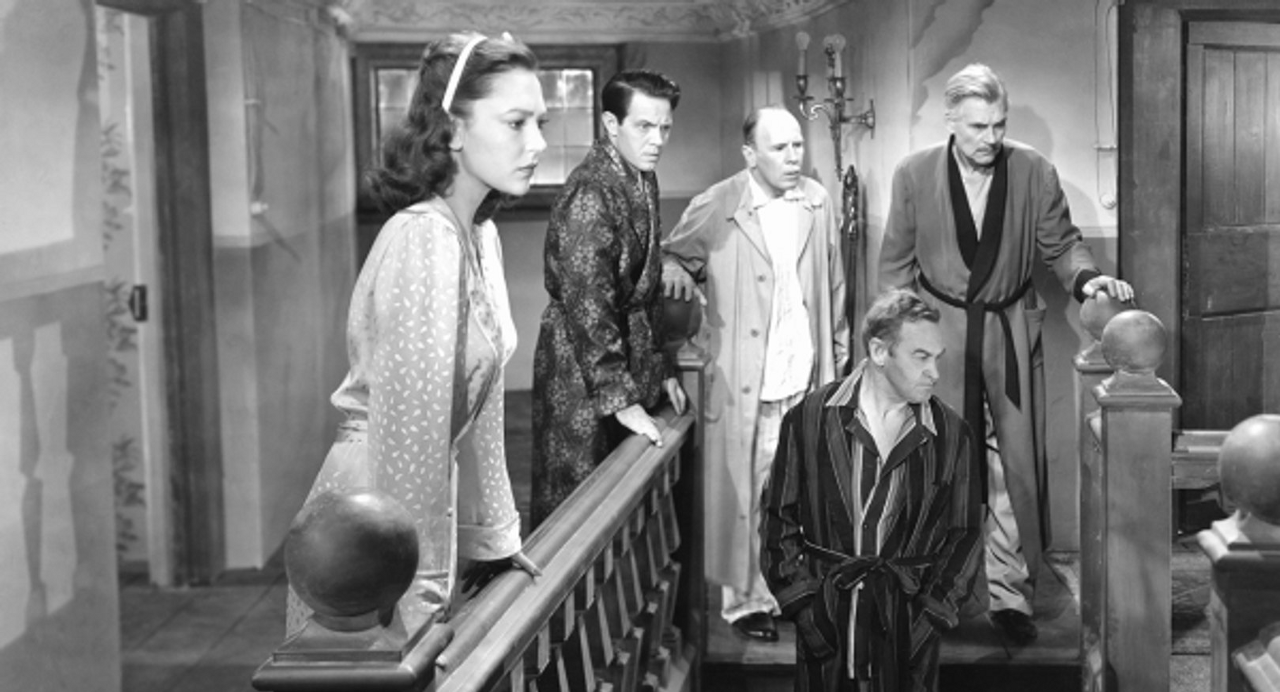And Then There Were None
Rating
![]()
Director
René Clair
Screenplay
Dudley Nichols
Length
1h 37m
Starring
Barry Fitzgerald, Walter Huston, Louis Hayward, Roland Young, June Duprez, Mischa Auer, Sir C. Aubrey Smith, Judith Anderson, Richard Haydn, Queenie Leonard, Harry Thurston
MPAA Rating
Approved
Review
One of the most celebrated and popular novels of all time, And Then There Were None proves a fitting source for adaptation in this chilling look at ten people brought to a remote island to answer for their crimes.
Agatha Christie wrote And Then There Were None under a more offensive title [1] in 1939 based loosely on a nursery rhyme about ten little figures whose escapades lead to their sequential deaths. For Christie’s novel, seven men and three women are the figures who find themselves trapped on an island with a killer who wants to punish them for “murders” they committed in the years preceding the events of the film.
The victims include a playboy, a pair of servants, a spinster, a private detective, a retired judge, a doctor, a governess, a general, and a soldier of fortune. Each of them were charged in the deaths of others, but were exonerated. Someone didn’t like their very public escape from justice and brought them together to do what the law was unable to do. It’s an age-old concept, vigilante justice, but it’s done in such a clever and fascinating way, it’s no surprise that it’s one of history’s most popular novels, having sold more than 100 million copies since its release.
Barry Fitzgerald, Walter Huston, Louis Hayward, Roland Young, June Duprez, Mischa Auer, C. Aubrey Smith, Judith Anderson, Richard Haydn, and Queenie Leonard play those individuals, three of whom have been given new names from those in the original book. It’s a strong roster of actors and they all deliver solid performances, but this film relies just as much on its atmosphere as it does its cast.
That atmosphere is crafted by director René Clair and cinematographer Lucien N. Andriot based on a screenplay by Dudley Nichols. Nichols’ script is mostly faithful to the novel, though it uses the 1943 stage adaptation’s ending, which blunts some of the impact. That decision doesn’t stop the film from largely succeeding and the black-and-white noir style befits the thrilling and salacious nature of the story and the murders committed.
This was the first of myriad adaptations of the novel, many of them have been in English, but nearly as many have been in languages other than, such as Tamil, Russian, and Spanish. This was the third adaptation I ever saw and, by then, the material was a bit more played out. I admire what they did with the film, but also feel it inferior to the next major adaptation, which went by the problematic title Ten Little Indians [1]. We can talk about that film then. For now, my opinion of And Then There Were None was that it was a solid effort, decently acted, but less atmospheric than its successor.
[1] In the United States, the “N” word has been classified as horrendously racist for more than a century. At the time Christie wrote her novel, that word was still in wide usage in England and hadn’t been deemed offensive as yet. As such, she released the title based on the included nursery rhyme, “Ten Little ‘N’s,” a minstrel rhyme that clearly shows its racist roots.
In subsequent editions, that title (and the poem) was at first changed to (the less offensive at the time) Ten Little Indians, but has in the last two decades been known by And Then There Were None with the entirely inoffensive “Soldiers” as the figures in the rhyme.
Of the other films I will be reviewing in the next few weeks, three are known by the “I” title while two (this and a later version) are known by And Then There Were None. The final two are in Hindi and Russian. That’s just a little history on the title and its subsequent alterations.
Review Written
September 12, 2023



















Leave a Reply
You must be logged in to post a comment.